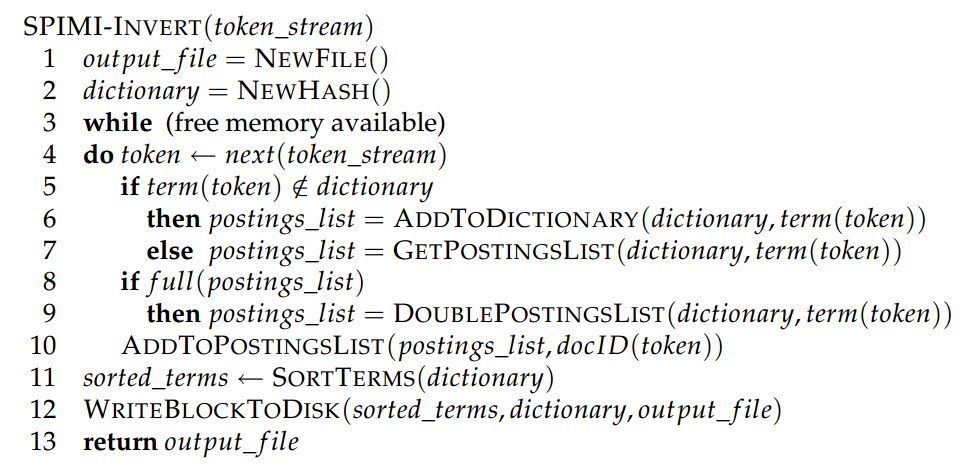目前正是所谓的“大数据”时代,数据量多到难以计数,怎样结构化的存储以便于分析计算,是当前的一大难题。上一篇博客我们简单抓取了1000个搜狐新闻数据,搜索的过程就是从这1000个新闻中找出和关键词相关的新闻来,那么怎样快速搜索呢,总不可能依次打开xml文件一个字一个字的找吧,这时就需要借助倒排索引这个强大的数据结构。
在讲倒排索引之前,我们先介绍一下布尔检索。布尔检索只是简单返回包含某个关键词的文档,比如查询“苹果手机”,则返回所有包含“苹果”和“手机”关键词的文档,布尔检索并不对返回结果排序,所以有可能返回的第一个文档是“某个男孩边吃苹果边玩手机...“。
实现布尔检索并不难,我们需要构建一个如下图的词项文档矩阵:
每行对应一个词项,每列对应一个文档,如果该值为1,表示该行词项出现在该列文档中。比如词项”苹果“出现在doc1和doc3文档中,如果我们要找同时出现”苹果“和”手机“的文档,只需把他们对应的向量取出来进行”与“操作,此为101&011=001,所以doc3同时出现了”苹果“和”手机“两个关键词,我们将其返回。
布尔检索虽然很快,但是它也有很多缺陷,比如不能对结果排序,词项只有出现和不出现两种状态,但是一篇文档中出现10次“苹果“和只出现1次”苹果“,他们的相关度肯定是不相同的。所以需要对布尔检索进行改进。
在扫描文档时,不但记录某词项出现与否,还记录该词项出现的次数,即词项频率(tf);同时我们记录该文档的长度(ld),以及某词项在不同文档中出现的次数,即文档频率(df)。
这样我们就得到了如上图的倒排索引。左边部分被称为词典,存储的是1000个新闻中所有不同的词项;右边部分被称为倒排记录表,存储的是出现Term_i的那些文档信息。倒排索引中存储的变量都是为了给后续检索模型使用。
讲到这里,我们需要解决如下几个问题。
- 怎样得到一篇文档中的所有词项。给我们一篇新闻稿子,人类很容易分辨出”苹果“和”手机“是两个不同的词项,但是计算机怎么知道是这两个词呢?为什么不是”苹”、”国手“和”机“呢?这就需要进行中文分词,我们可以借助开源的jieba中文分词组件来完成,jieba分词能够将一个中文句子切成一个个词项,这样我们就可以统计tf, df了。
- 有些词,如”的“、”地“、”得“、”如果“等,几乎每篇文档都会出现,他们起不到很好的区分文档的效果,这类词被称为”停用词“,我们需要把他们去掉。去停词的步骤可以在jieba分词之后完成。
- 怎样存储倒排记录表。假设1000个文档共有20000个不同的词项,如果用类似图1的矩阵形式存储,需要耗费1000*20000=2*10^7个存储单元,但是图1往往是一个稀疏矩阵,因为一个文档中可能只出现了200个不同的词项,剩余的19800个词项都是空的。用矩阵方式存储时空效率都不高。所以我们可以采用图2的方式,词典用B-树或hash存储,倒排记录表用邻接链表存储方式,这样能大大减少存储空间。如果我们要将图2保存到数据库,可以对倒排记录表序列化成一个长的字符串,写入到一个单元格,读取的时候再反序列化。比如每个Doc内部用'\t'连接,Doc之间用'\n'连接,读取的时候split即可。
倒排索引构建算法使用内存式单遍扫描索引构建方法(SPIMI),其实就是依次对每篇新闻进行分词,如果出现新的词项则插入到词典中,否则将该文档的信息追加到词项对应的倒排记录表中。SPIMI的伪代码如下:
下面是构建索引的所有代码:
# -*- coding: utf-8 -*-
"""
Created on Sat Dec 5 23:31:22 2015
@author: bitjoy.net
"""
from os import listdir
import xml.etree.ElementTree as ET
import jieba
import sqlite3
import configparser
class Doc:
docid = 0
date_time = ''
tf = 0
ld = 0
def __init__(self, docid, date_time, tf, ld):
self.docid = docid
self.date_time = date_time
self.tf = tf
self.ld = ld
def __repr__(self):
return(str(self.docid) + '\t' + self.date_time + '\t' + str(self.tf) + '\t' + str(self.ld))
def __str__(self):
return(str(self.docid) + '\t' + self.date_time + '\t' + str(self.tf) + '\t' + str(self.ld))
class IndexModule:
stop_words = set()
postings_lists = {}
config_path = ''
config_encoding = ''
def __init__(self, config_path, config_encoding):
self.config_path = config_path
self.config_encoding = config_encoding
config = configparser.ConfigParser()
config.read(config_path, config_encoding)
f = open(config['DEFAULT']['stop_words_path'], encoding = config['DEFAULT']['stop_words_encoding'])
words = f.read()
self.stop_words = set(words.split('\n'))
def is_number(self, s):
try:
float(s)
return True
except ValueError:
return False
def clean_list(self, seg_list):
cleaned_dict = {}
n = 0
for i in seg_list:
i = i.strip().lower()
if i != '' and not self.is_number(i) and i not in self.stop_words:
n = n + 1
if i in cleaned_dict:
cleaned_dict[i] = cleaned_dict[i] + 1
else:
cleaned_dict[i] = 1
return n, cleaned_dict
def write_postings_to_db(self, db_path):
conn = sqlite3.connect(db_path)
c = conn.cursor()
c.execute('''DROP TABLE IF EXISTS postings''')
c.execute('''CREATE TABLE postings
(term TEXT PRIMARY KEY, df INTEGER, docs TEXT)''')
for key, value in self.postings_lists.items():
doc_list = '\n'.join(map(str,value[1]))
t = (key, value[0], doc_list)
c.execute("INSERT INTO postings VALUES (?, ?, ?)", t)
conn.commit()
conn.close()
def construct_postings_lists(self):
config = configparser.ConfigParser()
config.read(self.config_path, self.config_encoding)
files = listdir(config['DEFAULT']['doc_dir_path'])
AVG_L = 0
for i in files:
root = ET.parse(config['DEFAULT']['doc_dir_path'] + i).getroot()
title = root.find('title').text
body = root.find('body').text
docid = int(root.find('id').text)
date_time = root.find('datetime').text
seg_list = jieba.lcut(title + '。' + body, cut_all=False)
ld, cleaned_dict = self.clean_list(seg_list)
AVG_L = AVG_L + ld
for key, value in cleaned_dict.items():
d = Doc(docid, date_time, value, ld)
if key in self.postings_lists:
self.postings_lists[key][0] = self.postings_lists[key][0] + 1 # df++
self.postings_lists[key][1].append(d)
else:
self.postings_lists[key] = [1, [d]] # [df, [Doc]]
AVG_L = AVG_L / len(files)
config.set('DEFAULT', 'N', str(len(files)))
config.set('DEFAULT', 'avg_l', str(AVG_L))
with open(self.config_path, 'w', encoding = self.config_encoding) as configfile:
config.write(configfile)
self.write_postings_to_db(config['DEFAULT']['db_path'])
if __name__ == "__main__":
im = IndexModule('../config.ini', 'utf-8')
im.construct_postings_lists()
运行之后会在./data/下生成一个ir.db数据库文件,这就是构建好的索引数据库。
完整可运行的新闻搜索引擎Demo请看我的Github项目news_search_engine。
以下是系列博客:



Pingback: 和我一起构建搜索引擎(一)简介 | bitJoy
Pingback: 和我一起构建搜索引擎(二)网络爬虫 | bitJoy
Pingback: 和我一起构建搜索引擎(七)总结展望 | bitJoy
Pingback: 和我一起构建搜索引擎(六)系统展示 | bitJoy
Pingback: 和我一起构建搜索引擎(五)推荐阅读 | bitJoy
Pingback: 和我一起构建搜索引擎(四)检索模型 | bitJoy
你好,我想请问下您的构建索引的过程中,出现的idf.txt文件是怎么生成的
请问 AVG_L 在这里的作用是什么?
刚看到,已经在GitHub中回复你了:https://github.com/01joy/news-search-engine/issues/1#issuecomment-611299791
博主您好,我跟着你的教程走了一遍,卡在第三步,有些问题想和你交流下
请问一下网页显示The server encountered an internal error and was unable to complete your request. Either the server is overloaded or there is an error in the application.是为什么呀
请问出现这个问题是为什么啊?
网页显示The server encountered an internal error and was unable to complete your request. Either the server is overloaded or there is an error in the application.